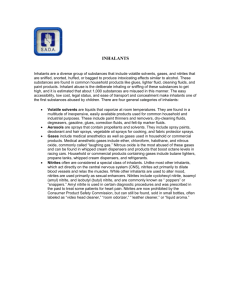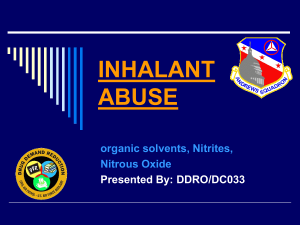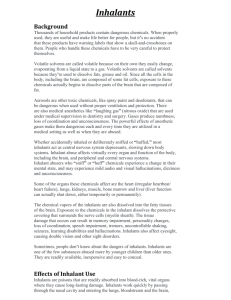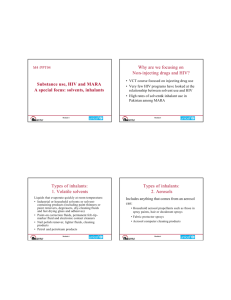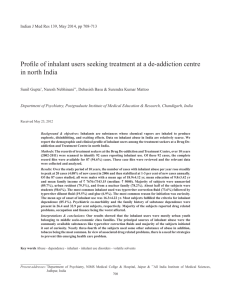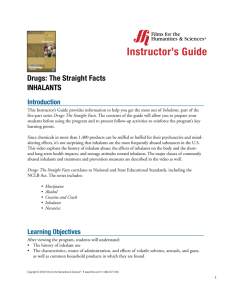“huffing” - inhalants - Montana Narcotics Officers Association
advertisement
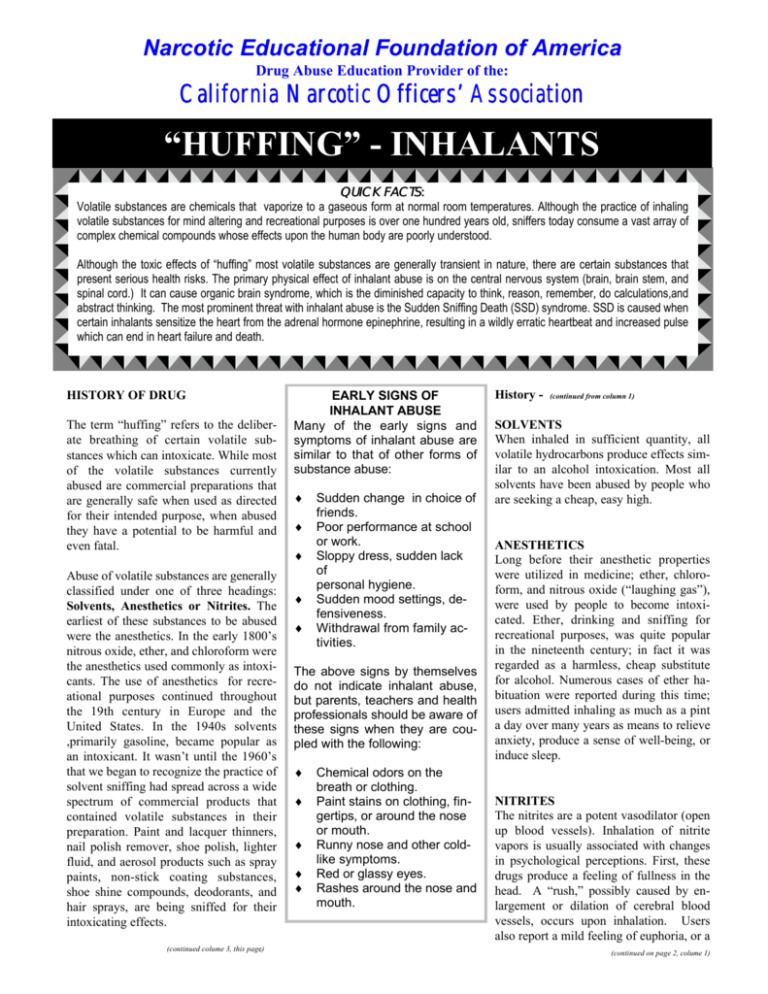
Narcotic Educational Foundation of America Drug Abuse Education Provider of the: California Narcotic Officers’ Association “HUFFING” - INHALANTS QUICK FACTS: FACTS: Volatile substances are chemicals that vaporize to a gaseous form at normal room temperatures. Although the practice of inhaling volatile substances for mind altering and recreational purposes is over one hundred years old, sniffers today consume a vast array of complex chemical compounds whose effects upon the human body are poorly understood. Although the toxic effects of “huffing” most volatile substances are generally transient in nature, there are certain substances that present serious health risks. The primary physical effect of inhalant abuse is on the central nervous system (brain, brain stem, and spinal cord.) It can cause organic brain syndrome, which is the diminished capacity to think, reason, remember, do calculations,and abstract thinking. The most prominent threat with inhalant abuse is the Sudden Sniffing Death (SSD) syndrome. SSD is caused when certain inhalants sensitize the heart from the adrenal hormone epinephrine, resulting in a wildly erratic heartbeat and increased pulse which can end in heart failure and death. HISTORY OF DRUG The term “huffing” refers to the deliberate breathing of certain volatile substances which can intoxicate. While most of the volatile substances currently abused are commercial preparations that are generally safe when used as directed for their intended purpose, when abused they have a potential to be harmful and even fatal. Abuse of volatile substances are generally classified under one of three headings: Solvents, Anesthetics or Nitrites. The earliest of these substances to be abused were the anesthetics. In the early 1800’s nitrous oxide, ether, and chloroform were the anesthetics used commonly as intoxicants. The use of anesthetics for recreational purposes continued throughout the 19th century in Europe and the United States. In the 1940s solvents ,primarily gasoline, became popular as an intoxicant. It wasn’t until the 1960’s that we began to recognize the practice of solvent sniffing had spread across a wide spectrum of commercial products that contained volatile substances in their preparation. Paint and lacquer thinners, nail polish remover, shoe polish, lighter fluid, and aerosol products such as spray paints, non-stick coating substances, shoe shine compounds, deodorants, and hair sprays, are being sniffed for their intoxicating effects. (continued colume 3, this page) EARLY SIGNS OF INHALANT ABUSE Many of the early signs and symptoms of inhalant abuse are similar to that of other forms of substance abuse: ♦ ♦ ♦ ♦ ♦ Sudden change in choice of friends. Poor performance at school or work. Sloppy dress, sudden lack of personal hygiene. Sudden mood settings, defensiveness. Withdrawal from family activities. The above signs by themselves do not indicate inhalant abuse, but parents, teachers and health professionals should be aware of these signs when they are coupled with the following: ♦ ♦ ♦ ♦ ♦ Chemical odors on the breath or clothing. Paint stains on clothing, fingertips, or around the nose or mouth. Runny nose and other coldlike symptoms. Red or glassy eyes. Rashes around the nose and mouth. History - (continued from column 1) SOLVENTS When inhaled in sufficient quantity, all volatile hydrocarbons produce effects similar to an alcohol intoxication. Most all solvents have been abused by people who are seeking a cheap, easy high. ANESTHETICS Long before their anesthetic properties were utilized in medicine; ether, chloroform, and nitrous oxide (“laughing gas”), were used by people to become intoxicated. Ether, drinking and sniffing for recreational purposes, was quite popular in the nineteenth century; in fact it was regarded as a harmless, cheap substitute for alcohol. Numerous cases of ether habituation were reported during this time; users admitted inhaling as much as a pint a day over many years as means to relieve anxiety, produce a sense of well-being, or induce sleep. NITRITES The nitrites are a potent vasodilator (open up blood vessels). Inhalation of nitrite vapors is usually associated with changes in psychological perceptions. First, these drugs produce a feeling of fullness in the head. A “rush,” possibly caused by enlargement or dilation of cerebral blood vessels, occurs upon inhalation. Users also report a mild feeling of euphoria, or a (continued on page 2, colume 1) History - (contined from page 1) perception that time has slowed down. Some users have mentioned an increase in sexual feelings as well. Research indicates that some kind of emotional disruption, from whatever source, stands out as the common factor pushing individuals into persistent use of inhalants. The most disturbed individuals are more likely to remain heavily involved because they obtain the greatest relief. Although inhalants are usually used by people under the age of eighteen, it is not limited to this age group, and many abusers in older age groups have been identified. VOLATILE SOLVENTS PRODUCT MAIN SOLVENT model cement, airplane glue toluene, acetone, naphtha rubber cement benzene fingernail polish remover acetone, ethyl acetate lighter fluid kerosene, naptha cleaning fluid carbon tetrachloride spot remover trichloromethane trichloroethane gasoline benzene compounds other aromatics AEROSOLS METHODS OF INGESTION The most common form of ingestion is by inhalation of the fumes of the solvents. This may be done in various ways, but the most frequent method is to place the volatile substance onto cloth material such as a sock. The sock’s toe area is generously coated with the volatile substance. The sock is wrapped in a fashion so as not to have the solvent come in direct contact with the skin. The opening of the sock is then placed to the nose and mouth area, and the fumes are inhaled into the body through a series of deep breaths. It is rumored that the spray paint color silver, gold, and clear contain higher concentrations of toluene, thus these seem to be the paints of choice. Another popular method of inhaling volatile substances (like glue and cements) is to saturate the inside of a paper or plastic bag so the fumes can be self contained at a concentrated level. The bag is then placed over the mouth and the opening is sealed against the cheeks. At this point the fumes are inhaled into the lungs, usually through one deep breath. (continued column 3, this page) PRODUCT MAIN SOLVENT spray paints toluene hair sprays dichlorodifluroroemethan (propellant 12) butane lighter butane propane propane Ingestion - (continued from column 1, this page) Gases under pressure, such as Nitrous Oxide, may be captured in toy balloons. The contents are then ingested through the balloon opening by placing it directly in the mouth, and releasing an amount with the two pinched off fingers directly on the tube. This container can be shared by several. The nitrites are usually contained in small glass bottles or ampules. These substances are sold under a variety of names including “RUSH, KICK, BELT, and JOCK AROMA.” These substances are generically called “POPPERS” because they are usually sold in small glass vials that are broken or popped, and then sniffed. SYMPTOMS OF ABUSE After inhalation the abuser will feel intoxicated and may appear to be drunk. The most visible objective symptoms are: • Poor coordination • Thick, slow and deliberate speech • Odor of substance on the breath • Excess nasal secretions • Watering of the eyes • Possibly enlarged pupils • Sneezing and coughing • Nausea and headache PROPELLANTS CAN BE HUFFED INHALANT TOXICOLOGY Although the toxic effects of sniffing most volatile substances are generally believed to be transient in nature, there are certain substances that present a serious health hazard. Toxic effects of a transient nature include acute organic brain syndrome, which is characterized by dizziness, loss of memory, inability to concentrate, confusion, and unsteady gait. Beyond these fairly common reactions to inhalants, toxicity problems become specifically related to different chemicals and combinations of chemicals. BREATH OF DEATH Deep breathing of the vapors, or using a lot over a short period of time, may result in losing touch with one’s surroundings, a loss of self-control, violent behavior, unconsciousness, or death. Using inhalants can cause nausea and vomiting, and if a person is unconscious when vomiting occurs, death can also result from aspiration (vomit getting into the lungs). Sniffing highly concentrated amounts of solvents or aerosol sprays can produce heart failure and instant death. Sniffing can cause death the first time or any time. High concentrations of inhalants, cause death from suffocation by displacing the oxygen in the lungs. Several reports offer suggestions about why inhalants might be the substance of choice among adolescents. The most obvious answer is the accessibility of the drugs. It has been said by experts that “if the label says it may be dangerous, that’s the one they will chose.” Many of them are household or Gasoline, a straight-chained hydrocarbon, is used in many rural and isolated areas. Gasoline has a number of toxic potentials, due to all of the additives in it. Triorthocryestl has been shown to cause spastic muscle wasting diseases, while lead additives can cause acute and chronic brain damage. In fact, gasoline inhalation should be investigated in young people with a history of lead poisoning with no other discernible source. Benzene is also found in gasoline and is associated with a number of blood disorders. Toxic effects will always reflective of a combination of individual agents. • • • Kidney damage Central nervous system damage (manifested by palsy-like symptoms) Sudden sniffing death syndrome (involves total heart failure) PSYCHOLOGICAL (Short term) • Mood swings • Acute depression • Passive-aggressive attitude • Poor self-esteem (Long-term) • Inhalant psychosis • Schizophrenia WHY INHALANTS ? GASOLINE CAN BE ABUSED! Effects - (continued from column 2) SNIFFING GLUE DEAR ANN: A boy in my class died a week ago. It was not a natural death. It was an accident that shouldn’t have happened. It occurred during lunch hour in the park across from our high school. DANGEROUS EFFECTS OF INHALANT ABUSE PHYSIOLOGICAL (Short term) • Severe headaches • Rashes around the nose and mouth • Weight loss • Red eyes, glassy eyes • Menstrual disorders • Irregular heartbeat • Lack of appetite • Frequent coughs/runny nose • Upper respiratory problems • Night sweats • Shortness of breath • Indigestion • Constipation • Acute poisoning (Long-term) • Brain damage • Liver damage “Jason” had been at a friend’s house. They were sniffing glue or lighter fluid, maybe both. On the way back to school, Jason kept blacking out. Finally, he fell and never got up. By the time we were able to get him to the hospital, it was too late. I am writing this letter to warn everyone who reads your column that sniffing anything from an aerosol can, correction fluid, or any kind of solvent can produce brain damage or death. If Jason had known how dangerous sniffing is, he never would have done it. I just hope that all his schoolmates who attended the funeral learned a lesson. As that dear, sweet boy lay in the satinlined casket, he looked so innocent. It seems such a shame that a young person should have to die to make people realize how dangerous drugs can be. WE’LL MISS HIM, CLEVELAND Printed from the L.A.Times with Lander’s permission This information is provided free of charge. Please feel free to duplicate it for distribution. For other publications, contact us at (661) 775-6960, or visit our web site at: www.cnoa.org
